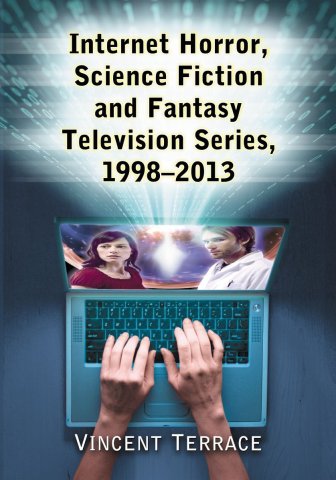Internet Horror, Science Fiction and Fantasy Television Series, 1998-2013
Vincent Terrace. Internet Horror, Science Fiction and Fantasy Television Series, 1998-2013. Jefferson: McFarland, 2014. Paperback, 284 pages, $39,95. ISBN 978-0-7864-7993-1
“A historicist criticism cannot be compared to a literary critical criticism, not because one is better than the other, but because they are apples and oranges” (89) writes Farah Mendelsohn in a piece about the theoretical aim of her work, which is based in her training as a historian, in comparison to literary criticism.
Her argument is, that literary scholars view each text as an original piece of writing, concentrating on the exceptional pieces and their value, whereas historians see the individual text as a piece in a greater puzzle, as “a brick in the castle of literature” (ibid.). This is not a deflation of the value of literature, but simply a question of outlook, Mendelsohn argues: “I as a historian think the castle is as interesting as the brick, for me, there is a narrative about how those bricks are made, how they fit together, and how they create the castle” (ibid.).
Keeping a Ledger of Media Production
In keeping with the analogy then, the approach employed by Vincent Terrace in his book Internet Horror, Science Fiction and Fantasy Television Series, 1998-2013 is neither to argue for the value of specific bricks as literary criticism would, nor to analyse how they all fit together to build this wonderful castle as Mendelsohn’s historicist criticism would. Instead, Terrace prefers to give us an inventory of all the bricks, as complete a list as he can get, detailing the measurements of each brick, the material it consists of and its weight. What value each brick holds or what possible structures could be built from it? Those questions are not his concern, the meticulous keeping of a ledger is.
If you will, Mr. Terrace has thus been the historian-accountant of television’s ‘bricks’ for more than thirty-five years, providing a library of publications, which take stock of all things television: shows, episodes, themes, pilots, specials, and characters. With his latest, the author adds to this immense repertoire another nuance of television so far not accounted, because it has only recently challenged traditional notions of TV. The internet, according to Lars Qvortrup, needs to be understood as a “‘multi-semantic system’, its main ‘quality’ being to integrate all known media into one converged multimedia system. The computer and the digital network is a medium that can copy any other medium” (350). As such, the Internet has become a new platform for television, one that offers an alternative mode of publication to classic broadcast or cable services. New formats, new production methods and especially new forms of distribution have become available via the convergence medium Internet. Television series are no longer a matter of large budgets and professional studios, instead digitalization makes it possible for media consumers to become producers, allows consumption of specific texts by a global “communication community” (limited by access to the digital media only; Qvortrup ibid.) and thus opens spaces for new forms of social, political or aesthetic commentary.
Encyclopedic Information on 400 series
Terrace’s book offers an encyclopedic account of this dramatic shift in media format, as it chronicles over 400 television series (or web series) that have been exclusively distributed through the Internet in the last 15 years. It offers the website, a synopsis of the show, an episode guide and some information on actors and credited production personnel, if available, for each of these series. Terrace also feels the need to provide a short commentary on the show in question. Though these provide a first evaluation of the series, their erratic format (some as short as 2-3 lines, some as long a 2-3 paragraphs) and orientation (focusing on anything from special effects, to acting, to narrative arc, to production value) make them highly unreliable.
In general, the encyclopedic value of the book is high, giving a thorough account of the ‘bricks’ that media scholars might want to use when building their specific castles: Are you looking for vampire love stories, camp science fiction or high fantasy to build your next paper presentation? No problem, you can find material here – that is, with time and effort when browsing the book. The ultimate problem, the one Terrace has missed when dealing with the new ‘multi-semantic system,’ is that it continuously changes and adds different layers of meaning on top of old ones.
Analog Medium to Tally Digital Content
First, problems already arise in the research for a project like this. The entries given in this book are highly irregular and prone to changes. Series from obscure sources or in hard to reach national places – like China or India – are not even considered. Some entries simply have gone ‘cold’: some productions are made by non-professionals, thus websites can easily be switched off or episodes can be taken down. Others are now gathered in aggregator-websites or streaming-services, thus have become hidden behind a paywall or need to be searched from their archives. Also, the quality of both show and entry vary immensely: SyFy or Netflix productions are included and offer a broadcast television style production, whereas some Youtube-series might not even name its creator and have only a single pilot episode. (At which point does a show constitute a series, one might ask?)
Second, and even more of a fallacy when dealing with a medium that also works as a “meta-archive” in which “knowledge can be accessed through search engines” (Qvortrup 350), is that the book itself as an encyclopedia is utterly out-dated. As a scholar, looking for zombie TV series, I will have to painstakingly look through the book and note down each time the series’ description mentions the word ‘zombie’. There is an index, but it only provides names of people (most of which are completely unknown) and titles of series (which are the sorting basis for the entries anyway), not specific themes. In dealing with the new medium and its technological and social dimension, the author should have realized the irony in capturing digital information in an analogue medium. Instead of a book, Terrace would have been more astute in creating an online archive. This could have been updated regularly, producers could have contacted him to be included and it would have been digitally accessible for research. That this is possible and very useful is not only proved by the Internet Speculative Fiction Database (www.isfdb.org), which catalogues literary works of SF, but also by the transmutation of the Encyclopedia of Science Fiction (www.sf-encyclopedia.com) into an online archive, migrating from print to online with its third edition. But maybe, after having discovered “an exciting new world of television programming” (2) on the internet, Mr. Terrace will also be able to embrace the ‘exciting new world of publishing’ that it offers and move his otherwise very intriguing work into the digital age. An account of all that is there, archived and readily available for research, would provide us with the ultimate opportunity to examine the ‘bricks’ and build ‘castles’ from this new digital source material.
Works Cited
Mendelsohn, Farah. “Warum schreibt eine Geschichtswissenschaftlerin über Science Fiction?” Trans. Julia Schmeink. Zeitschrift für Fantastikforschung 1.3 (2013): 88-96. Original manuscript by Mendelsohn used for the citations.
Qvortrup, Lars. “Understanding New Digital Media: Medium Theory or Complexity Theory?” European Journal of Communication.21 (2006): 345-56.
Originally published in SFRA Review #311 (2014).
Schmeink, Lars. “Vincent Terrace. Internet Horror, Science Fiction and Fantasy Television Series, 1998-2013 ” SFRA Review 311 (2014): 32-33.

